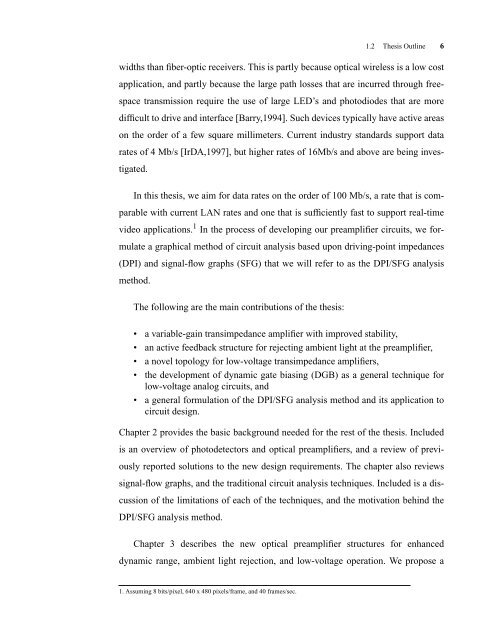CMOS Optical Preamplifier Design Using Graphical Circuit Analysis
CMOS Optical Preamplifier Design Using Graphical Circuit Analysis
CMOS Optical Preamplifier Design Using Graphical Circuit Analysis
You also want an ePaper? Increase the reach of your titles
YUMPU automatically turns print PDFs into web optimized ePapers that Google loves.
1.2 Thesis Outline 6<br />
widths than fiber-optic receivers. This is partly because optical wireless is a low cost<br />
application, and partly because the large path losses that are incurred through free-<br />
space transmission require the use of large LED’s and photodiodes that are more<br />
difficult to drive and interface [Barry,1994]. Such devices typically have active areas<br />
on the order of a few square millimeters. Current industry standards support data<br />
rates of 4 Mb/s [IrDA,1997], but higher rates of 16Mb/s and above are being inves-<br />
tigated.<br />
In this thesis, we aim for data rates on the order of 100 Mb/s, a rate that is com-<br />
parable with current LAN rates and one that is sufficiently fast to support real-time<br />
video applications. 1 In the process of developing our preamplifier circuits, we for-<br />
mulate a graphical method of circuit analysis based upon driving-point impedances<br />
(DPI) and signal-flow graphs (SFG) that we will refer to as the DPI/SFG analysis<br />
method.<br />
The following are the main contributions of the thesis:<br />
• a variable-gain transimpedance amplifier with improved stability,<br />
• an active feedback structure for rejecting ambient light at the preamplifier,<br />
• a novel topology for low-voltage transimpedance amplifiers,<br />
• the development of dynamic gate biasing (DGB) as a general technique for<br />
low-voltage analog circuits, and<br />
• a general formulation of the DPI/SFG analysis method and its application to<br />
circuit design.<br />
Chapter 2 provides the basic background needed for the rest of the thesis. Included<br />
is an overview of photodetectors and optical preamplifiers, and a review of previ-<br />
ously reported solutions to the new design requirements. The chapter also reviews<br />
signal-flow graphs, and the traditional circuit analysis techniques. Included is a dis-<br />
cussion of the limitations of each of the techniques, and the motivation behind the<br />
DPI/SFG analysis method.<br />
Chapter 3 describes the new optical preamplifier structures for enhanced<br />
dynamic range, ambient light rejection, and low-voltage operation. We propose a<br />
1. Assuming 8 bits/pixel, 640 x 480 pixels/frame, and 40 frames/sec.














